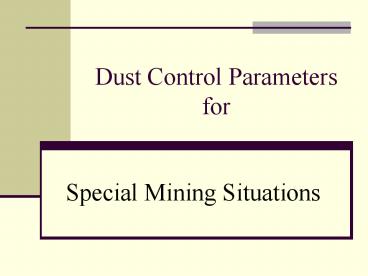Dust Control Parameters for - PowerPoint PPT Presentation
1 / 19
Title:
Dust Control Parameters for
Description:
Result in the activation of a MMU requiring requisite sampling by MSHA and ... Utilize wet drilling (or dust collection system) Wet down muck prior to load out ... – PowerPoint PPT presentation
Number of Views:218
Avg rating:3.0/5.0
Title: Dust Control Parameters for
1
Dust Control Parametersfor
- Special Mining Situations
2
Special Mining Situations
- In-Mine Construction Plans
- Seam-to-Seam Slope Construction Plans (slopes
that originate in underground workings and take
mining operations from one seam to another) - Sandstone Channel or Washout Plans
3
Overall
- All three have parameter requirements on bit
maintenance - All three have parameter requirements on water
spray configurations and spray maintenance - Scrubber use has been discouraged in construction
plans - Scrubber use has not been allowed in Slope and
Sandstone Channel Plans
4
In-Mine Construction
- Belt Channels
- Overcasts
- Grading Bottom
- Shearing Ribs
- Rehab of Old Works
5
Requested Parameters
- Dust control parameters to protect employees
doing construction activities - Description of equipment used for construction
work (e.g. continuous mining machine) - Description of the ventilation including air
direction, volume of air, velocities, entry
height and width - Statement that no one will be working downwind of
construction activity - Statement that construction crew will not be
working in the return air of an actively
producing mechanized mining unit (MMU) - If a continuous mining machine is utilized to cut
material, a minimum number of sprays and water
pressure (PSI) - Location and intervals of methane tests
6
Both Seam-to-Seam Slope and Sandstone Channel
Plans
- Require operator to meet with MSHA
- Review hazards involved explain Agency concerns
- Review operators initial draft and provide input
from each technical group involved - Result in the activation of a MMU requiring
requisite sampling by MSHA and the operator - Recommend pre-project chest x-rays
- Subsequently meet with crews on site
- Why we asked for the parameters in place
- Recommend respirator use
- Recommend chest x-ray
7
Seam-to-Seam In-Mine Slopes
- Developed under Part 75
- Electrical Group has overall oversight (as in
Surface-to-Seam slopes) - Initiated with group meeting of all involved
parties (operator and technical groups).
Operator presents rough draft. - Routed through several technical groups
- Roof Control
- Ventilation
- Health
- Impoundments (for blasting plan)
8
To date slope construction has consisted of
- Drilling and blasting rock faces
- Loading accomplished with continuous mining
machine - Trimming (dressing) ribs and roof accomplished
with continuous mining machine - Set of equipment assigned a mechanized mining
unit (MMU) number for the duration of the project - MMU abandoned upon completion of the project
9
Minimum Parameters Required
- Meet requirements of Part 75 (vs Part 77)
assigned an MMU number - Auxiliary fan with exhaust tubing in faces
(minimum of 9,000 cfm) - No one down wind of cutting, loading, mining, or
drilling operations - Utilize wet drilling (or dust collection system)
- Wet down muck prior to load out
- Continuous miner operator to be located outby end
of tubing
10
(No Transcript)
11
MSHA Inspector Dust Sample Results Mine
ID 4608808 Current Operator Spartan Mining
Co., Inc. Please Note Spartan Mining Co., Inc.
has been the current operator since
11/1/1999Concentrations greater than 2.0 mg are
shown in Red
Note MSHA Total Average 0.089 mg/m3
12
Operator Sample Results
13
Sandstone Channel or Washout
- Coordinated by Health Group
- Impoundment Group involved in approval of
blasting plans - Ventilation Groups involved in projections and
any ventilation changes - Roof Control Group determines if any plan changes
were necessary, particularly if entry size varies
14
Example Mine Developing through Sandstone Channel
- Originally projected to be three entries
developed1200 to 1800 feet through sandstone
channel - Quartz analysis later revealed strata
consistently ranged from 40 to 60 silica - Need to mine through channel first reported by
roof control specialist. Operator contacted by
Health Group - MMU plan developed specifically for this project
- Blasting plan also developed specifically for
this project
15
To date entries developed through sandstone
channels consisted of
- Drilling and blasting rock faces
- Loading accomplished with continuous mining
machine - Trimming ribs and roof accomplished with
continuous mining machine - Set of equipment assigned an mechanized mining
unit (MMU) number for the duration of the project - MMU abandoned upon completion of the project
16
Minimum Parameters Required
- Auxiliary fan with exhaust tubing in each face
(minimum 9,000 cfm) - No one down wind of cutting, loading, mining, or
drilling operations - Utilize wet drilling (or dust collection system)
- Wet down muck prior to load out
- Miner operator to be located outby end of tubing
17
(No Transcript)
18
Sandstone Channel
- Actual project took 18 months
- Operator provided approximately 13,000 cfm at the
end of the tubing - Each employee was sampled once per week through
special arrangement with Pittsburgh Dust Lab - In 18 months, two samples exceeded
- 1 mg/m3 the remainder were in the 0.1 to 0.4
mg/m3 range (300 approx.) The entity was on
reduced standards as low as 0.3 mg/m3
19
As this project approached completion MSHA
personnel visited the mine and reviewed sample
history with both management and the crew working
the channel entry construction. Conveyed MSHAs
appreciation for the efforts taken to control
silica dust levels during this project and
requested feedback on the parameter
requirements. Both operator and miners involved
indicated that while they had initially resisted
using auxiliary fans, they were grateful that
MSHA insisted on their use. They indicated there
was a world of difference in the level of dust
to which they were exposed when using normal
ventilating curtain compared to auxiliary fan
tubing.































